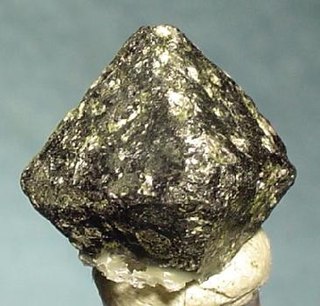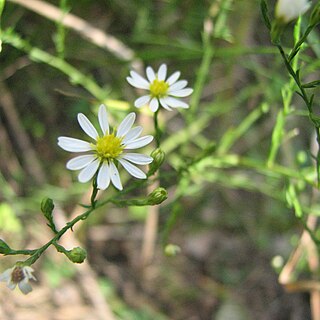
Owings Mills is an unincorporated community and census-designated place in Baltimore County, Maryland, United States. It is a suburb of Baltimore. Per the 2020 census, the population was 35,674. Owings Mills is home to the northern terminus of the Baltimore Metro Subway, and housed the Owings Mills Mall until its closure in 2015. It is also home to the Baltimore Ravens' headquarters facility, and the studios for Maryland Public Television. In 2008, CNNMoney.com named Owings Mills number 49 of the "100 Best Places to Live and Launch".

Serpentine subgroup are greenish, brownish, or spotted minerals commonly found in serpentinite. They are used as a source of magnesium and asbestos, and as decorative stone. The name comes from the greenish color and smooth or scaly appearance from the Latin serpentinus, meaning "serpent rock".

Chromite is a crystalline mineral composed primarily of iron(II) oxide and chromium(III) oxide compounds. It can be represented by the chemical formula of FeCr2O4. It is an oxide mineral belonging to the spinel group. The element magnesium can substitute for iron in variable amounts as it forms a solid solution with magnesiochromite (MgCr2O4). A substitution of the element aluminium can also occur, leading to hercynite (FeAl2O4). Chromite today is mined particularly to make stainless steel through the production of ferrochrome (FeCr), which is an iron-chromium alloy.

Serpentinite is a rock composed predominantly of one or more serpentine group minerals formed by near to complete serpentinization of mafic to ultramafic rocks. Its name originated from the similarity of the texture of the rock to that of the skin of a snake. Serpentinite has been called serpentine or serpentine rock, particularly in older geological texts and in wider cultural settings.

Serpentine soil is an uncommon soil type produced by weathered ultramafic rock such as peridotite and its metamorphic derivatives such as serpentinite. More precisely, serpentine soil contains minerals of the serpentine subgroup, especially antigorite, lizardite, and chrysotile or white asbestos, all of which are commonly found in ultramafic rocks. The term "serpentine" is commonly used to refer to both the soil type and the mineral group which forms its parent materials.
Isaac Tyson Jr. (1792–1861) was a Quaker businessman from Baltimore, Maryland, who held a virtual monopoly on world supplies of chromium minerals during the mid-19th century and a very successful entrepreneur and industrialist.
Cardiff is an unincorporated community in Harford County, Maryland, United States. The zip code for the area is 21160. The community name is taken from the Capital city of Wales.

Bloede's Dam was a hydroelectric dam on the Patapsco River in Maryland. Built in 1906, it was the first submerged hydroelectric plant—that is, the power plant was housed under the spillway. It was also one of the earliest dams constructed of reinforced concrete. The dam was demolished in 2018 and its site is now part of Patapsco Valley State Park Avalon Area.
In 1988, the Professional Soil Classifiers Association of Mississippi selected Natchez silt loam soil to represent the soil resources of the State. These soils exist on 171,559 acres of landscape in Mississippi.

Patapsco Valley State Park is a Maryland state park extending along 32 miles (51 km) of the Patapsco River south and west of the city of Baltimore, Maryland. The park encompasses multiple developed areas on over 14,000 acres (5,700 ha) acres of land, making it Maryland's largest state park. In 2006, it was officially celebrated as Maryland's first state park, its first formation being in 1906. Patapsco Valley State Park is managed by the Maryland Department of Natural Resources.
Maryland Wildlands are a group of public properties that are protected from logging or other activities in the state of Maryland.

Symphyotrichum depauperatum, commonly known as serpentine aster or starved aster, is a rare species in the family Asteraceae adapted to serpentine barrens, an ecosystem with a high concentration of toxic metals in the soil. It has been found in Pennsylvania, Maryland, and on some diabase glades in North Carolina. It grows to 50 centimeters and has white ray florets surrounding a center of yellow disk florets.

The Bare Hills Historic District encompasses a residential area north of Baltimore, Maryland, in Baltimore County, which had industrial beginnings before being transformed into a suburb of the city. The district includes Lake Roland Park as well as a cluster of largely vernacular dwellings between the park and Falls Turnpike that was built mainly in the 19th century.
The Staten Island Serpentinite locality is a southward extension of the New England Uplands, adjacent to the Manhattan Prong. It includes Todt Hill on Staten Island, which is the highest point along the Atlantic Seaboard south of Maine, at 410 feet (120 m) above sea level. "Todt" is a Dutch word meaning "dead." This hill perhaps received its name from the Dutch settlers because the hilltops overlooking The Narrows consisted of scattered treeless rocky exposures. The chemical character of the bedrock was, in part, the reason for this. Much of Staten Island is covered by the Harbor Hill moraine, the terminal moraine of the last Wisconsin Stage glacier. However, ledges of bedrock consisting of serpentinite are exposed throughout the upland areas on Staten Island. Grymes Hill, the second highest point on Staten Island and just a few miles from Todt Hill has similar bedrock characteristics. Serpentine, the dominant mineral in serpentinite, is rich in magnesium, an element that most plants cannot tolerate in high concentrations. The enrichment of magnesium in the thin serpentine soil covering the glacier-scoured hilltops is probably responsible for the original barren exposures on Todt Hill.

State Line Serpentine Barrens is a 60-square-mile (160 km2) tract of serpentine barrens in Pennsylvania and Maryland in the eastern United States. The protected area is actually an assemblage of six tracts owned by a combination of the Nature Conservancy, the State of Pennsylvania, two counties, a township, and private owners. The largest tract is Nottingham County Park in Chester County, which has also been deemed a National Natural Landmark. The second-largest is Goat Hill Serpentine Barrens, jointly owned by the Nature Conservancy and the Pennsylvania Forestry Department, and the third-largest, Chrome Serpentine Barrens, is jointly owned by Elk Township and the Nature Conservancy. Rock Springs Preserve in Lancaster County is managed by the Lancaster Conservancy.











